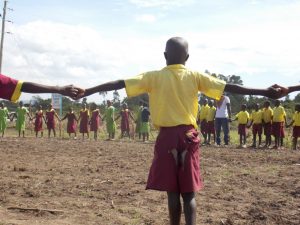
School children from Ikerege Ward, Kuria West sub-county during the launch of Maclyne Community Library, the first community library in Migori county
Three decades later Kenya is still grappling with the advent of rife HIV/AIDS stigmatization.
This has led to innovative ways to deal with this problem through culturally accepted practices that offer a source of insurance and hope to the people.
With the ideology mirrored, AphiaPlus Western Program engaged existing caregiver groups including WESAFE, Dago Dala Hera, OBACODEP, and KAWIRI to respond to the needs of Orphans and Vulnerable Children (OVC) in Migori County.
We met Jane Sigu who is a Technical Specialist currently heading the drive to quality improvement of OVC life. Here she was able to narrate to us some of the struggles that she faces driving the philosophy of result based management to such huge membership
“When I first interacted with the groups, I was excited that they are already doing something for the orphans and vulnerable children” adding some of the barriers faced by the initiative included long distances, competition and lack of capacity building amongst members.
Jane noted “I noticed that some members of the group advanced faster than others especially on matters of household economic strengthening.
These issues in my view threatened the very existence of the groups. In my mind, such setting exposed targeted children from social protection.” Jane says.
According to the Kenya National Aids Control Council an estimated number of children living with HIV in Migori County is 10,705. This indicates that additional effort is required to reach more children. Currently, only 28% of poor households with orphans are beneficiaries of a cash transfer programme.
Jane struggled through a period of self-reflection on how best to turn things round. It was not until 2013 that she attended a Quality Improvement (QI) training offered by ASSIST project.
“As the QI training unfolded, I picked on innovation as a critical component and said to myself, I will try it out,” Jane narrates.
In consultation with caregivers and coaching the team on the possible implementation phases, Jane developed a strategy to reorganize members for maximization of group activity returns.
Her initiative included marketing the new concept to the the local NGOs to allow smaller group coordination that would help improve efficacy in delivering and sustaining quality life for the vulnerable children.
It’s here the teams embraced the continued coaching process as a way to improve performance and focus on the groups, resulting to a quicker buy-in. As a result of multiple consultation, Watano Initiative was birthed to manage the Groups looking after the vulnerable children in Migori County.
According to Jane, besides that fact that the twist from large to small groups aided in building better social ties among caregivers, reducing stigma and discrimination, creating Watano Initiatives as focal expert points for community queries on matters vulnerable children.
This has led to the formation of a self help group that is tasked to ensure the sustainability of the group. Here Caregivers are not only able to give the basic care but also they are financially stable.
Jane notes “Reports of increased group savings and loaning warmed my heart. I quickly knew that I am breeding caregivers who are financially empowered.”
The caregivers now are much competitive and can beat the odds in a country with low social welfare mechanism.
Small scale business are said to have grown to approximately USD 53,000. Strategies employed in the Watano enterprise include animal husbandry and farming to ensure there’s food security achieved in the county.
Members of Watano group have ensured make-over of their households and can now guarantee quality education for their families. In addition, and in tandem with the group the hold daily meetings ensures all children are tested and those requiring treatment and care are linked appropriately.
The vulnerable children are also enrolled under the health care system by the National Hospital Insurance Fund which gives medical cover to the children.
“In my view, the years 2013 to 2015 have been fruitful. I have a better administrative and management structure, motivated caregivers and quality life for OVC.” Jane notes.

